-
Behaviour Scoring
-
- 1. Anxious in unfamiliar situations
- 2. Fear Of Noises
- 3. Fear of Novel Objects
- 4. Fear of Underfootings
- 5. Fear of Dogs
- 6. Fear of Stairs
- 7. Fear of Traffic
- 8. Separation Anxiety
- 9. Hyper-Attachment
- 10. Fear Of Strangers
- 11. Body Handling Concern
- 12. Retreats When Reached For
- 13. Harness Handle On Back Sensitivity
- 14. Avoidance Of Blowing Fan
- 15. Body Sensitivity To Object Contact
- 16. Anxious About Riding In Vehicles
- 17. Inhibited or passively avoidant when exposed to potentially stressful situations
- 18. Activated when exposed to potentially stressful situations
- 19. Excitable
- 20. Slow To Return To Productive Emotional State
- 21. Fidgety When Handler Is Idle
- 22. Fear On Elevated Areas, Drop-Offs Etc.
- 23. Barks Persistently
- 24. High Energy Level
- 25. Lacks Focus
- 26. Movement Excites
- 27. Chasing Animals
- 28. Dog Distraction
- 29. Sniffing
- 30. Scavenges
- 31. Inappropriate Behavior Around The Home
- 32. Lacks Initiative
- 33. Not Willing
- 34. Resource Guarding Toward People
- 35. Aggression Toward Strangers
- 36. Aggression Toward Dogs
- 37. Resource Guarding Toward Dogs Or Other Pets
- 38. Inappropriate Elimination While Working En Route
- 39. Socially Inappropriate Behavior With People
- 40. Inconsistent
- 41. Handler/Dog Team
- 42. Relationship Skills
- 43. Comparison 9 To 1 Score
- 44. Socially Inappropriate Behavior With Dogs
- 45. Thunder Reaction Prior To, During Or Immediately After A Thunderstorm
- 46. Kennels Poorly
- 47. Working Speed
- 48. Gait When Moving Out
- 49. Housebreaking Problems
- 50. Innate Desire To Work
- 51. Avoidance Of Exhaust From Vehicles
- Show all articles ( 36 ) Collapse Articles
-
-
-
Practice Videos
-
Behavior Testing
-
Database User Manual
-
-
-
- Adding a New Dog (using Manage Your Dog’s Data, MyDogs)
- Alerts
- BCL, Behavior Checklist
- Elbow Quick, Add new
- Estrus & Whelps
- Eye Quick
- Genetic Test Panel
- Genetic Test Quick
- Health Diagnoses Add/Edit
- Health History Report
- Health Normals, Add new
- Heart Quick
- Hip BVA, Add new
- Hip FCI, Add new
- Hip OFA, Add new
- Hip Penn Hip, Add new
- Photos PDFs etc.
- Private Notes
- Procedures, Add new
- Reminders
- Share my dog data to another organization
- Skin Quick
- Status History
- Weight - Entering a dog's weight
- ADI Public Access Test
- Hip Vezzoni, Add new
- Status Detail
- Edit or Change Call Name / Pedigree Name / Owner ID
- Add New Microchip / Delete Incorrect Microchip
- End Reasons
- Juvenile Estrus
- Communications Activities
- Incidents
- Show all articles ( 18 ) Collapse Articles
-
- Articles coming soon
-
-
-
-
- Alternate Therapy/Rehab
- Diagnostic Imaging, Add new / Edit or Delete
- Diet
- Elbow Quick, Add new / Edit or Delete
- Estrus & Whelps, Add new
- Eye Quick, Add new / Edit or Delete
- Genetic Test Quick, Add new / Edit or Delete
- Health Diagnoses, Add new / Edit (Update) or Delete
- Health History Report, Generate a PDF
- Health Normals
- Health Screening List
- Hip OFA Add new / Edit or Delete
- Hip Penn Hip Add new / Edit or Delete
- Hospitalization, Add new
- Kennel Tasks, Add new / Edit or Delete
- Lab, Add new / Edit or Delete
- Photos, PDFs, etc., Add new
- Reminders Add new / Edit or Delete
- Rx, Add new / Edit or Delete
- Semen Cryo, Add new / Edit or Delete
- Skin Quick Add new / Edit or Delete
- SOAP, Add new / Edit or Delete
- Status History
- Supplies Used, Add new / Edit or Delete
- Surgery, Add new
- Treatments Add new / Edit or Delete
- Vaccines Add new / Edit or Delete
- Weight and BCS Body Condition Score - Add new / Edit or Delete
- Hip Vezzoni, Add new
- Show all articles ( 14 ) Collapse Articles
-
-
-
-
Early Socialization
-
- Video - Coat Desensitization
- Video - Novel Objects
- Video - Trolley Ride with Mom
- Early Puppy Socialization - Novel Objects video
- Early Puppy Socialization – Novel Sounds video
- Early Puppy Socialization – Introducing New Environments video
- Early Puppy Socialization – Motor Development, Balance, Coordination, Proprioception video
- Early Puppy Socialization – Passive Environmental Enrichment in the Den video
- Early Puppy Socialization – Stairs
-
-
Genetic Selection & Inbreeding
-
- What are EBVs and how do they help?
- How EBVs are calculated
- What is needed to calculate EBVs and EBV accuracy?
- Using EBVs effectively
- Selection index
- Why are EBVs different for littermates?
- Presentation Recording: Improving behavior using EBVs
- Presentation Recording: Using EBVs successfully
- Presentation Recording - Improving health using EBVs
-
Webinars
-
Reproduction
-
Organization Management
Maximizing Litter Size − Timing When to Inseminate
Small litter size is most commonly caused by inseminating at the wrong time. One would think that since sperm can live in the female vaginal tract for up to one week, and eggs are fertilizable for at least a four day period, that breeding close to the right date would be fine; however, that is not the case.
Many new breeding managers do not realize that a bitch’s breeding behavior does not always coincide with the right time to mate. This is because standing and flagging, willingness to accept a male, the color of the vaginal discharge (thinning from blood to thinner), and the change in the vaginal smear are all influenced by estrogen. Estrogen is a hormone that readies the uterus, vagina, and behavior of the bitch, but it is NOT the hormone that controls when the eggs ovulate.
The important hormone that triggers ovulation is called Luteinizing Hormone (LH). After the eggs are released, cells in the crater-like space in the ovary where the egg was release a very important hormone called Progesterone.
Eggs are most fertile 3 to 5 days after ovulation occurs; however, a bitch may exhibit prime mating behavior many days earlier or later than the peak time for fertilizing the eggs. Insemination at the wrong time can result in low conception rates or small litter sizes. If insemination is too early, there are fewer live sperm when the eggs are ready to be fertilized. If insemination is too late, the eggs may have disintegrated due to being too old or the cervix may have closed.
Combining progesterone testing with LH testing is an ideal method for selecting the prime breeding date. A spike in LH occurs 48 hours prior to ovulation. There is only one LH surge and it only last 24 hours. Dogs produce immature oocytes at ovulation. Once ovulated, these oocytes require 48 hours to mature enough to handle fertilization by sperm. Therefore, if we know the date of ovulation, we can choose the optimal breeding dates.
On the chart below, the pink spike is the rise in LH. It can be measured by a blood test run in-house by using a test kit available from Synbiotics, CA, (http://www.synbiotics.com/Products/Canine_Reproduction.html). The test kits cost about $20.00 US per test and have a short shelf life.
The blue line on the chart below is the progesterone level as it is measured every other day. As you can see, the LH rise tends to be around the time the progesterone value jumps from <1.5 ng/ml to >2 ng/ml. For countries using nmol/l instead of ng/ml, nmol/l can be easily converted to ng/ml by simply multiplying by 0.315. Keep in mind that the exact value may vary from dog to dog, and some interpretation must be done.
By running progesterone levels at a laboratory every other day, the increase in progesterone can be monitored. Initial progesterone values at a brood’s heat start typically should be <0.2ng/ml. If you get a value <0.2ng/ml, you can be assured that the brood is early in her heat. Since in some bitches, the progesterone value at
the start of the heat is higher than <0.2ng/ml, it is important to obtain a blood sample within the first 48 hours of heat start to have a baseline number on that particular bitch.
If the value is >0.2ng/ml, verify that her vaginal cytology is also early (<50% cornification). Values under 1.2 ng/ml are typically still too early for a LH surge, especially if the blood from two days prior was 0.8. But if her blood from two days prior was only 0.2, a surge is possible at the low value of 1.2. When you see a brood that has a value of 1.5 or above, you should plan to do an LH test.
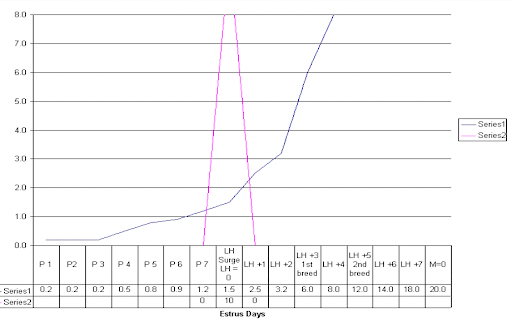
It can often be difficult to pinpoint the best day to run an LH test, so it ends up being a judgment call on each brood. Below is a chart used by Guiding Eyes for the Blind that serves as a guide on when to ship blood to the laboratory for progesterone assays, and when to run the LH test based on the progesterone result.

Once you have determined the day you think is the LH spike day, run an LH test to confirm. It is prudent to also test the blood sample collected a day prior to the date the LH was high, because sometimes that day may also be high. It is not necessary to test two days prior as the LH surge only lasts for up to two days. LH=0 is the first date that the LH level is high (test kit results are positive).
For the sake of accuracy, try to obtain blood samples around the same time of day to assure the most accurate LH levels. Once a positive LH surge is found, that day is called LH=0. The prime breeding days are LH+3 and LH+5.
It is very helpful to get the progesterone values for each of the two breeding days, as a means of double-checking your LH=0 date, especially if LH tests are not available.
- The 1st breeding’s progesterone value should be >6ng/ml.
- The 2nd breeding’s progesterone value should be >12 ng/ml. If the value is not that high, a third breeding must be considered.
The diagram below is from the Synbiotics website. It summarizes the peak fertility period and the value of vaginal cytology, vaginoscopy, and progesterone values as breeding timing aids. Vaginal cytology and vaginoscopy are useful but less accurate means of evaluating the peak fertility period, because they are secondary responses to estrogen levels. They will be discussed below.
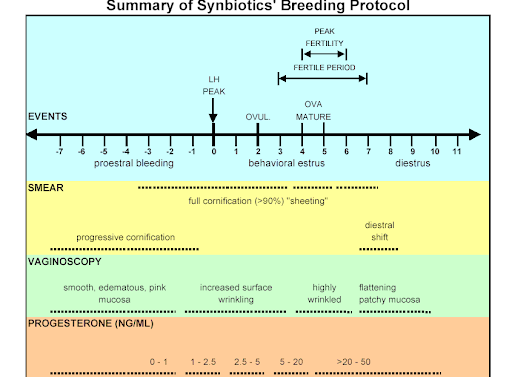
Inseminate at the right time:
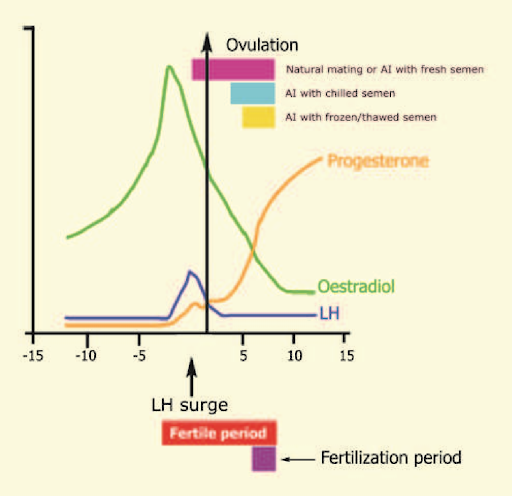
- LH 5 & 7 Sperm lives 12-24 hours max – Must inseminate during fertilization period
Use laboratory that calibrates progesterone and LH assay for dogs
Don’t use kits for FS insemination timing – Not accurate enough
Synbiotics recommendation for timing inseminations based on the LH peak
Note that Synbiotics recommends breeding natural or fresh AI on days 2, 4, and 6 after the LH peak. Experience in large breeding colonies such as Guiding Eyes for the Blind has yielded success by breeding on days 3 and 5 after the LH peak.
Frozen semen matings are normally a little later than fresh semen. Days 4 and 6 after the LH rise are considered the ideal for transcervical insemination, or Day 5 for a single surgical insemination.
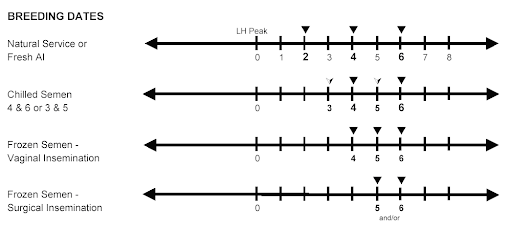
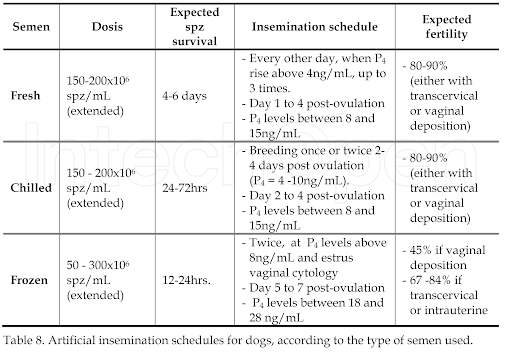
Artificial Insemination in Dogs, Rita Payan-Carreira1, Sónia Miranda2 and Wojciech Niżański, Poland
In review, there are five key tools utilized for timing bitches:
- Progesterone Levels
- LH testing
- Vaginoscopy
- Vaginal Cytology
- Receptivity.
Considerations regarding these tools are summarized below :
Quantitative Progesterone Assays
- Expensive test (and shipping costs, if necessary)
- Availability of testing labs. Since human progesterone is much higher than in dogs, utilizing labs that typically test humans can lead to inaccurate results, because their machines are not calibrated for accurate readings of low levels of progesterone, especially <.2 ng/ml)
- Consistency and accuracy of results over the in-house test kits
- Get baseline value at heat start
- Initial rise correlates with LH surge
- Several tests weekly required
LH testing
- Expensive test (currently $20/test at Synbiotics, USA)
- It is unknown whether Synbiotics or another supplier can provide LH testing kits internationally
- Freeze serum daily on the bitches and only run LH tests on the day(s) you suspect are indicative of an LH surge. (If so, you will use approximately 2 tests per bitch)
- LH testing used in conjunction with progesterone testing is highly successful
Vaginoscopy − see attachment in references
- Inexpensive
- Very informative if used correctly
- Same person should do it every time for consistency
- Maximum crenulation typically correlates with prime fertile period
Vaginal Cytology − see attachment in references
- Inexpensive, requires microscope
- Technique very important for accurate results
- Cytologies vary significantly from bitch to bitch based on their estrogen levels, so not super reliable at pinpointing fertile period.
- Presence of high % of cornified cells is a useful indicator to start Progesterone and/or LH testing
Receptivity
- Most inexpensive if stud dog is available
- Most unreliable, many bitches will stand in proestrus
- Some safety concerns for dogs and handlers
